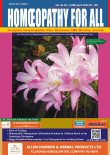Examining the Influence of COVID-19 on PCOS Symptoms and the Role of Homeopathy in their Alleviation
Keywords:
COVID-19, metabolic, mechanismAbstract
Polycystic ovarian syndrome (PCOS) is a prevalent endocrine disorder affecting reproductive-aged women worldwide, characterized by hormonal imbalances, irregular menstrual cycles, ovarian cysts, and various metabolic disturbances, hyperandrogenism, ovulatory dysfunction, and polycystic ovarian morphology.1 Over the past couple of years, the world has been grappling with the devastating effects of the COVID-19 pandemic caused by the novel coronavirus, SARS CoV-2. While the primary impact of COVID-19 is respiratory, emerging evidence suggests that the virus can have wide-ranging effects on other organ systems, including the endocrine system. When we examine its effects on the female endocrine system, it results in menstrual irregularities, hormonal imbalances, fertility issues, etc. Apart from its direct effects, even the use of COVID-19 vaccine is also reported to influence the menstrual cycle length, flow, duration of menstruation, symptoms, and abnormal bleeding without an effect on post-menopausal vaginal bleeding.2 All these may possibly end up in PCOS due to multiple factors, including hormonal imbalance, stress, and others. Researchers have also traced its possible mechanism to be related to the increased androgen activity, which make the body vulnerable to infections.
Downloads
References
Rotterdam, E.A.-S.P.c.w.g. Revised 2003 consensus on diagnostic criteria and long-term health risks related to polycystic ovary syndrome (PCOS). Hum. Reprod. 2004, 19, 41–47.
Farah, Stephanie, et al. "Effect of COVID‐19 vaccinations on menstrual cycle and postmenopausal bleeding among health care workers: A cross‐ sectional study." International Journal of Gynecology & Obstetrics (2023).
Winck Yamamoto, M. M., Lin Winck Yamamoto, A. K., & Barbosa, B. B. (2022). Polycystic ovary syndrome and risks
for COVID-19 infection: A comprehensive review: PCOS and COVID-19 relationship. Reviews in Endocrine & Metabolic Disorders, 23(2), 251-264. https://doi.org/10.1007/s11154-
-09715-y
Subramanian, Anuradhaa, et al. "Increased COVID-19 infections
in women with polycystic ovary syndrome: a population-based study." European journal of endocrinology 184.5 (2021): 637-
Moin A.S.M., Sathyapalan T., Butler A.E., et al. Vitamin D association with macrophage derived cytokines in polycystic ovary syndrome: an enhanced risk of COVID-19 infection? Front Endocrinol. 2021:12. doi: 10.3389/fendo.2021.638621.
Dissanayake, Harsha. "COVID-19 and metabolic syndrome." Best Practice & Research Clinical Endocrinology & Metabolism (2023): 101753.
Huffman AM, Rezq S, Basnet J, Yanes Cardozo LL, Romero DG. SARS-CoV-2 viral entry proteins in hyperandrogenemic female mice: ımplications for women with PCOS and COVID-19. Int J Mol Sci. 2021;22:4472.
Bechmann, Nicole, et al. "COVID-19 Infections in Gonads: Consequences on Fertility?." Hormone and Metabolic Research (2022).
Hussain, Nabeel, et al. "A systematic review of acute telogen effluvium, a harrowing post‐COVID‐19 manifestation." Journal of medical virology 94.4 (2022): 1391-1401.
Madaan S, Jaiswal A, Kumar S, Talwar D, Halani D. Premature ovarian failure-A long COVID sequelae. Medical Science, 2021,
(112), 1286-1290
Bestle, D.; Heindl, M.R.; Limburg, H.; Van Lam van, T.; Pilgram, O.; Moulton, H.; Stein, D.A.; Hardes, K.; Eickmann, M.; Dolnik, O.; et al. TMPRSS2 and furin are both essential for proteolytic activation
of SARS-CoV-2 in human airway cells. Life Sci. Alliance 2020, 3, e202000786.
W. Boericke, New Manual of Homoeopathic Materia Medica & Repertory [with Relationship of Remedies], Second Re-Augmented & Revised Edition Based on Ninth Edition, Reprint Edition 2002, B. Jain Publishers, New Delhi.
R. Murphy, Lotus Materia Medica, Third Revised Edition, B. Jain Publishers, New Delhi.
W. H. Burt, Physiological Materia Medica, B. Jain Publishers, New Delhi.
Hashem, Nesrein M., et al. "Potential impacts of COVID-19 on reproductive health: Scientific
findings and social dimension." Saudi Journal of Biological Sciences 28.3 (2021): 1702-1712.




